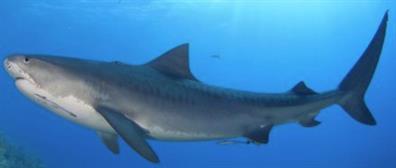





Galeocerdo cuvier
| Ecological Descriptors |
||||
| Habitat | Size | Diet | Behaviour | Sex |
| Pel | 5.5m | Car | I | F |
Description:
Blueish to brownish grey with pale underside and darker vertical bars may be seen on flanks. Body stout, but becoming very slender towards the rear. Snout is blunt, short and broad. The last 2 gill slits are over the pectoral fin. Spiracle behind eye.
Broad based first dorsal fin is larger than second dorsal and has a pointed tip and concave rear edge. The second dorsal fin arises distinctly in front of anal fin origin and has a long free rear tip. The tail has large upper lobe.
Juveniles have large dark spots, some coalescing to form bars.
Ecology
Found at depths from 0-1112 m (0-3,400ft), living for ~27 years.
Primarily nocturnal predators, usually, found in deep waters offshore in the daytime and feeding in shallower water at night.
Generalist carnivores and carrion feeders, they do not chase prey over long distances, but rather employ short high speed bursts tod to
capture prey.
Solitary excluding when feeding on larger carcasses and in the mating season. Social hierarchy is displayed during communal feeding where the physically bigger sharks eat initially. They have very large home ranges.
Life Cycle:
Mate every three years, with a 16 month gestation, leading to the live birth in deeper water of 10-80 young, each 80-85cm long and weighing 3-6kg .
Embryos are initially fed from a yolk sac, with no placental connection, so the mother’s body is equipped for gas exchange to the unborn shark. When this sac is nutrient deprived, foetuses gain nutrients from uterine secretions.
Breeding seasons vary in different locations, but is generally March to May in the Northern hemisphere. They have a slow growth rate, with males maturing at 310 cm and females at 315-320cm.
Blueish to brownish grey with pale underside and darker vertical bars may be seen on flanks. Body stout, but becoming very slender towards the rear. Snout is blunt, short and broad. The last 2 gill slits are over the pectoral fin. Spiracle behind eye.
Broad based first dorsal fin is larger than second dorsal and has a pointed tip and concave rear edge. The second dorsal fin arises distinctly in front of anal fin origin and has a long free rear tip. The tail has large upper lobe.
Juveniles have large dark spots, some coalescing to form bars.
Ecology
Found at depths from 0-1112 m (0-3,400ft), living for ~27 years.
Primarily nocturnal predators, usually, found in deep waters offshore in the daytime and feeding in shallower water at night.
Generalist carnivores and carrion feeders, they do not chase prey over long distances, but rather employ short high speed bursts tod to
capture prey.
Solitary excluding when feeding on larger carcasses and in the mating season. Social hierarchy is displayed during communal feeding where the physically bigger sharks eat initially. They have very large home ranges.
Life Cycle:
Mate every three years, with a 16 month gestation, leading to the live birth in deeper water of 10-80 young, each 80-85cm long and weighing 3-6kg .
Embryos are initially fed from a yolk sac, with no placental connection, so the mother’s body is equipped for gas exchange to the unborn shark. When this sac is nutrient deprived, foetuses gain nutrients from uterine secretions.
Breeding seasons vary in different locations, but is generally March to May in the Northern hemisphere. They have a slow growth rate, with males maturing at 310 cm and females at 315-320cm.
Tiger Shark





(C) Florida Museum
Tiger Shark
(C) Indigo Divers




606


